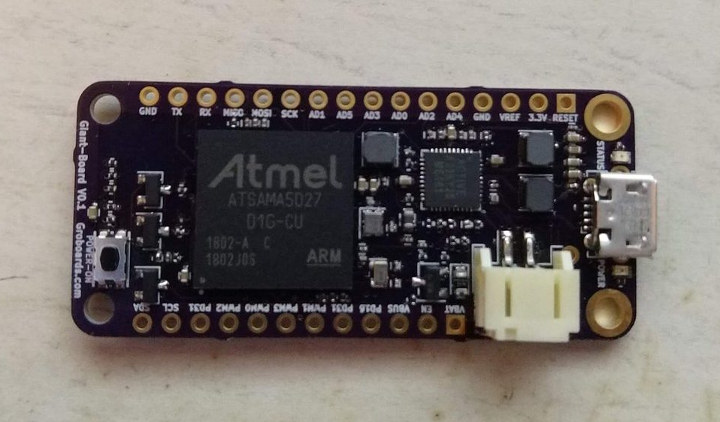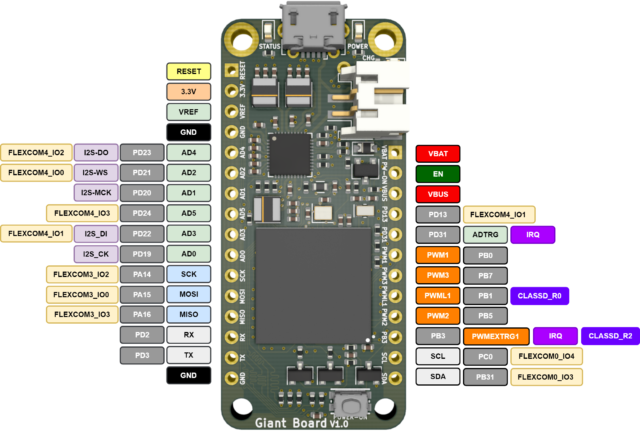Earlier this year we gave you details about some new development board, most especially about the Giant board. A tiny single board computer that runs Linux on Arm Cortex-A5 processor.
This super tiny single-board computer (SBC) is based on the Adafruit Feather form factor. Unlike its name, the giant board is actually a small microchip. And it packs an awful lot of power for its size. The news is that it has launched on Crowd Supply for $50 and up.
In addition, the giant board implements the power of size, which makes it unique. It squeezes SBC into a package the size of a microcontroller board. This will in turn relax memory, storage, and processing constraints. Consequently allowing you to effectively work on your projects.

Another thing to know about the Giant Board is that it runs full Debian Linux. Giving developers and users access to an endless number of applications and libraries for their projects.
Also, it supports the Adafruit FeatherWing pinout. This allows it to work with over 60 pre-existing add-on boards.
Remember that Adafruit released a set of libraries that adds CircuitPython support to Linux. The board is compatible with Adafruit and has access to over 100 hardware libraries.
You can also use an Ethernet FeatherWing to give your Giant Board access to the Internet. It has also been tested with Wi-Fi and LCD FeatherWings.
The board is currently open source, and its parts can be gotten at retail stores.

Uses of the Giant Board
It can be used for projects related to the following;
- Media streaming
- IoT gateway routing
- Data collection & analysis
- Robotics
Board Specs
- Processor: Microchip SAMA5D2 ARM Cortex-A5 Processor 500 MHz
- Memory: 128 MB DDR2 RAM
- Storage: microSD card
- Sensing: 6 x 12-bit ADC with 3.3 V reference and external trigger
- Actuation: 4 x 16-bit PWM with external trigger
- Connectivity: 1 x I²C, 1 x SPI, 1 x UART, more with Flexcom
- Power: via USB, with support for LiPo batteries
- Operating System: mainline Linux kernel

Tiwalade Joanna Okedara is a content writer, and blogger, with a passion for all things tech. She also specialises in writing SEO content, and spends most of her time researching new content marketing strategies. She loves to cook, and plan events in her spare time
Support CNX Software! Donate via cryptocurrencies, become a Patron on Patreon, or purchase goods on Amazon or Aliexpress





Running normal debian seems like a bad idea if this is going to be used for prototyping where the power will get pulled at random all the time. $50 seems a lot when the pocket beagle is $25 imho.
I’m not really sure what advantage running Linux could be on a platform so limited on io. Maybe I’m missing something at the moment, but I don’t really see any real advantage over a uC, other than compensating a lack of embedded knowledge of the programmer by relying on Linux’ driver infrastructure.
>I’m not really sure what advantage running Linux could be on a platform so limited on io. The io is slightly limited but there are good reasons you want linux. Just having memory protection means your little app(s) can crash all day long and not hurt anything. As your code gets more complex the chance of having to chase a memory corruption bug because of a programming error or running out stack increases. If you really have to code in C you get the advantage of being able to use GDB without pissing around with JTAG and getting the target… Read more »
This would be great with a minimalist linux distribution created via Yocto or buildroot + busybox. I think Debian might be a bit overkill for it. I think an Onion Omega 2+ with 128MB of RAM a similarly clocked CPU and openWRT (minimalist Linux Distro intended for routers) is a better option than this. Oh it also has WiFi and costs only $13. The only advantage of this board over the onion omega 2+ is possibly that this has a built-in ADC and LiPo support. Still it is a cute little board with a SAMA5 part which is rare.
Did the onion omega stuff ever get a mainline kernel? This thing is cortex a so it’s one of the best supported cpus in the kernel. MIPS on the other hand seems to be on life support.
The Omega Onion and this board are both intended for the hobbyist market. Not really the industrial one. So who cares. Even if a SOC has a mainline kernel, absent a decent source of OS images, not many are going to want to create their own OS by generating a file system, compiling the kernel, compiling GPU drivers if necessary, adding other drivers and so forth. So in that sense who cares. Having said that the SAMA5 is a pretty neat SOC. I just don’t think that this form factor is ideal. It would be better to develop an SBC… Read more »
>Not really the industrial one. So who cares.
You should care. Putting aside not wanting to have stuff with known security issues on your network; Imagine a driver for some i2c widget is only present in versions after whatever vendor kernel you have. You now either don’t get to use the driver or have to back port it. That’s a massive pain and hinders your progress every time you want to use something that should be supported but isn’t because you’re stuck on some LTS kernel if you’re lucky.
>You should care.
Perhaps. If I can find a SAMA5 board with WiFi that costs around $20 USD I’d switch in an instant. I guess I could also run openWRT on a RPi Zero W
How much RAM and CPU is left for user apps after Linux is loaded and running?